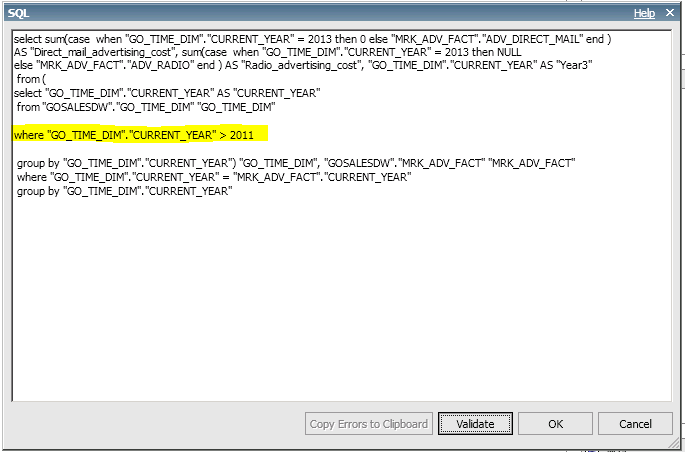Sometimes you may like to hide some section of a report when running it in Excel/ PDF output format. One way to do this might be to create a render variable based on the ReportOutput() function, and hide the object that way. Some objects, however don't support a render variable.
You can use (Don't Print) class to hide any item in a Cognos report. The (Don't Print) class will exclude the item from the output. Here are the steps to take
- Select the object which you want to hide
- click on Classes property under Properties pane
- Select (Don't Print) class under Global Classes list
- Save and run the report
Cognos Nuggets
Tip of the day
Comments in an expression in report studio :
#/*Here are the comments*/#
use it to your advantage!
#/*Here are the comments*/#
use it to your advantage!
Automatically refreshing a report
Hi!
ever wonder how to automatically refresh a report every ...say 3 seconds? Just paste this into a HTML item in your report.
ever wonder how to automatically refresh a report every ...say 3 seconds? Just paste this into a HTML item in your report.
<script>
function reloadthispage()
{
t=setTimeout("promptButtonFinish()",3000);
}
reloadthispage();
</script>
Combination chart as a visualization
Version 10.2.1.4 of IBM Cognos BI brings a new and long awaited chart type as a visualization for consumption in an active report : the combination chart.
Many business users want to use these types of charts as they contain a lot of information combined. Be sure to check it out :
https://www.analyticszone.com/homepage/web/displayMarketplacePage.action#catalog/viz_assets_combination
Many business users want to use these types of charts as they contain a lot of information combined. Be sure to check it out :
https://www.analyticszone.com/homepage/web/displayMarketplacePage.action#catalog/viz_assets_combination
Configuring an apache DS namespace : a pitfall
Apache Directory Server is a great free LDAP alternative. There are number of good tutorials out there on how to configure Apache DS as a security namespace in IBM Cognos Configuration. I won't be repeating all these steps, instead I'll paste a link below.
http://www.cornerstone.com.au/blog/view/installing-apacheds-for-cognos-bi-10-2-1
However, I would like to mention a pitfall when using more recent versions of Apache DS. Most tutorials indicate that "uid" should be configured as unique identifier. In some cases, IBM Cognos Configuration might come up with the error message below when testing the namespace.
http://www.cornerstone.com.au/blog/view/installing-apacheds-for-cognos-bi-10-2-1
However, I would like to mention a pitfall when using more recent versions of Apache DS. Most tutorials indicate that "uid" should be configured as unique identifier. In some cases, IBM Cognos Configuration might come up with the error message below when testing the namespace.
Quite an annoying error message, as it doesn't give you too much detail. Turns out you just have to revert the unique identifier property to its default ("dn") in order to make it work, just like in the screenshot below.
Did you know... you can change the sql of a query in report studio?
In report studio, you typically create queries by dragging the metadata into a query. However, in some cases you're just not satisfied with the SQL that query generates, and you want to go and fiddle with it.
There's an easy way to do so, just click the query you want to edit, and click the "Generated SQL" property. A window pops up that shows you the SQL, and click the "Convert" button at the bottom of the dialog.
In the dialog that follows, just change the query.
Click OK, and you will see that Report Studio changed the query in to a SQL query object.
There's an easy way to do so, just click the query you want to edit, and click the "Generated SQL" property. A window pops up that shows you the SQL, and click the "Convert" button at the bottom of the dialog.
In the dialog that follows, just change the query.
Click OK, and you will see that Report Studio changed the query in to a SQL query object.
Please note that running SQL directly in your report is a separate capability that can be activated or deactivated in the security settings in Cognos Administration. The same thing can be done with MDX when creating a report on multidimensional data.
The message is : use caution when editing your own query.
Starting a dynamic cube from the command line
Doing maintenance on a dynamic cube in IBM Cognos 10 is quite straight-forward. It's even possible to schedule some maintenance tasks, like stopping and starting a cube, and refreshing the data cache by creating an administrative task in the Administration module, and creating a schedule on top of it.
IBM Cognos Business Intelligence 10.2.1.1 Fix Pack 3 introduces a new and exciting tool called DCAdmin, in which you can do all of these tasks from the command line. This allows an administrator to incorporate starting and stopping dynamic cubes from within another process.
For instance : stop cubes before an ETL load in order to save memory on the server, and starting them again after the ETL has completed. Just one example of how such a tool might come in handy.
You can check out this article on the IBM support site for more information on how to use this tool.
http://www-01.ibm.com/support/docview.wss?uid=swg27040451
Good luck!
IBM Cognos Business Intelligence 10.2.1.1 Fix Pack 3 introduces a new and exciting tool called DCAdmin, in which you can do all of these tasks from the command line. This allows an administrator to incorporate starting and stopping dynamic cubes from within another process.
For instance : stop cubes before an ETL load in order to save memory on the server, and starting them again after the ETL has completed. Just one example of how such a tool might come in handy.
You can check out this article on the IBM support site for more information on how to use this tool.
http://www-01.ibm.com/support/docview.wss?uid=swg27040451
Good luck!
Abonneren op:
Reacties (Atom)




